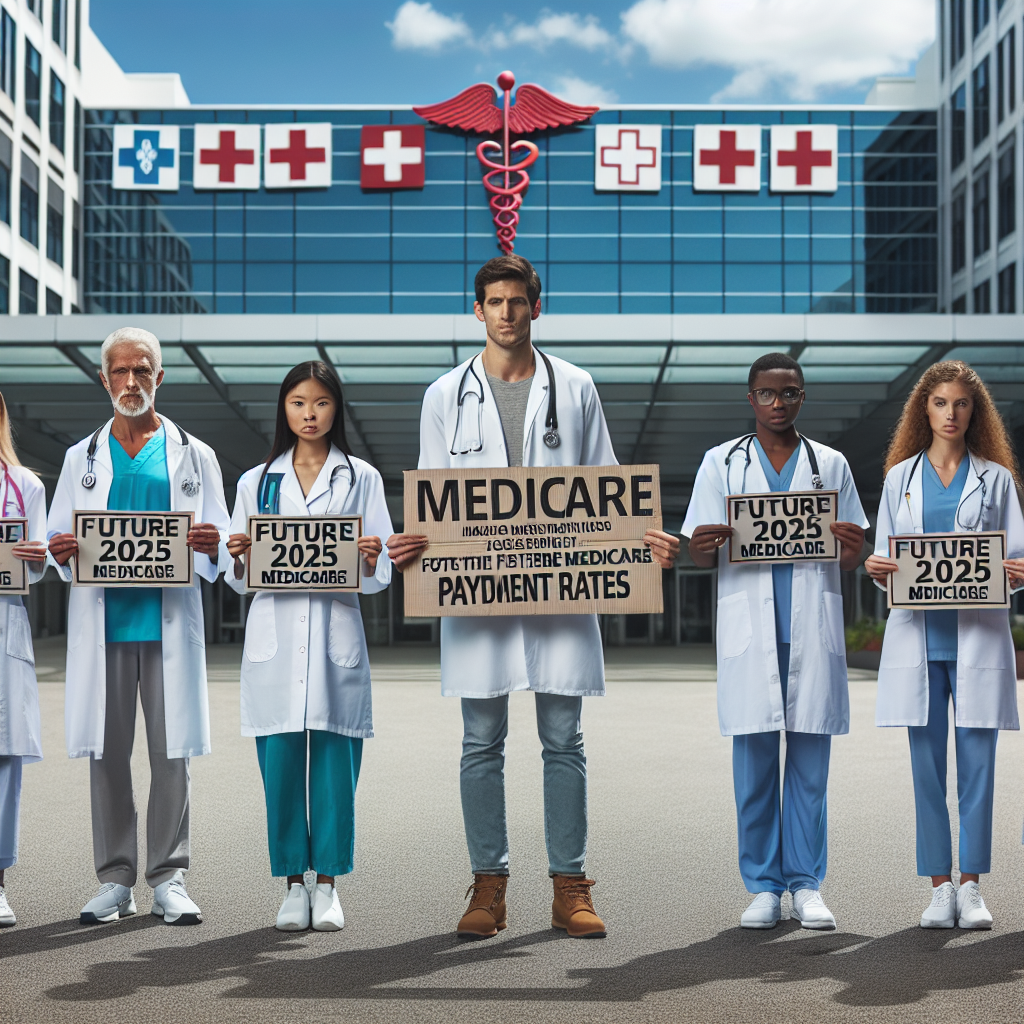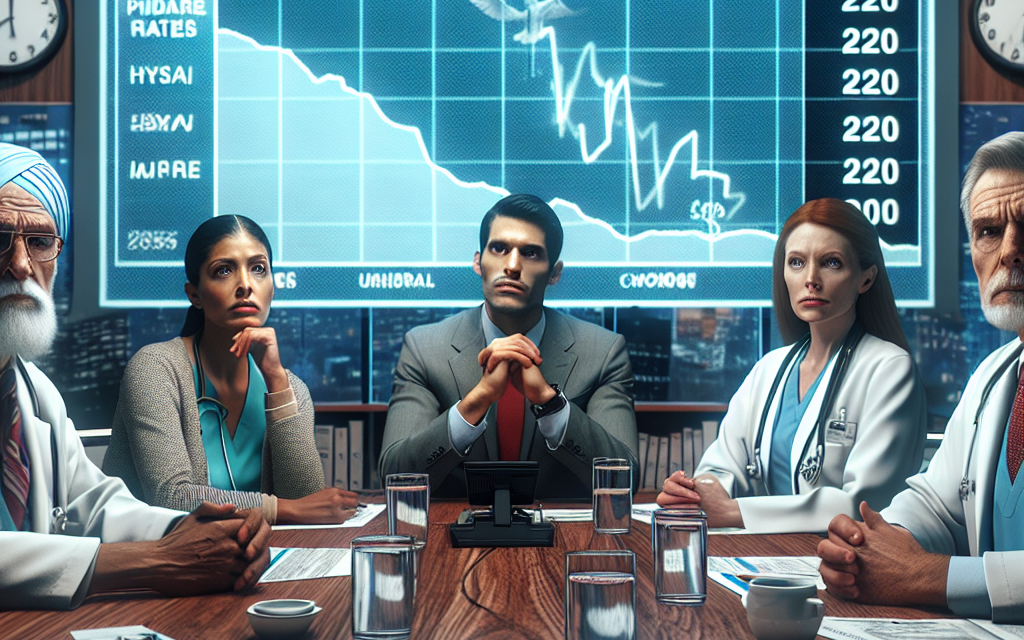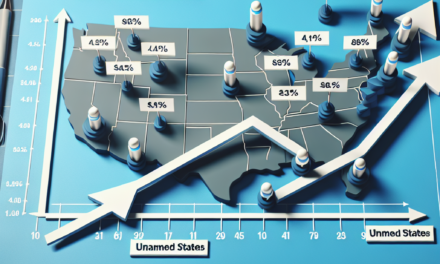Doctors and Hospitals Criticize 2025 Medicare Payment Rates

The healthcare industry is once again at a crossroads as the Centers for Medicare & Medicaid Services (CMS) announced the 2025 Medicare payment rates. These rates have sparked significant criticism from doctors and hospitals across the United States. The new payment structure is seen as a potential threat to the financial stability of healthcare providers and the quality of care available to Medicare beneficiaries. This article delves into the various aspects of the 2025 Medicare payment rates, exploring the concerns raised by healthcare professionals and institutions, and examining the potential implications for the healthcare system.
Understanding the 2025 Medicare Payment Rates
The 2025 Medicare payment rates are part of the annual adjustments made by CMS to determine how much healthcare providers will be reimbursed for services rendered to Medicare beneficiaries. These rates are crucial as they directly impact the financial viability of hospitals and clinics, influencing their ability to provide quality care. The adjustments are based on a complex formula that considers factors such as inflation, changes in medical practice, and budgetary constraints.
In 2025, CMS has proposed a modest increase in payment rates, which many healthcare providers argue is insufficient to cover the rising costs of delivering care. The proposed rates have been met with criticism from various quarters, with stakeholders expressing concerns about the potential impact on patient care and the sustainability of healthcare practices.
The Formula Behind the Rates
The formula used to calculate Medicare payment rates is a subject of much debate. It involves several components, including the Medicare Economic Index (MEI), which measures changes in the costs of providing medical services. The MEI is adjusted for productivity gains, which CMS assumes healthcare providers can achieve over time. However, many argue that these assumptions are overly optimistic and do not reflect the realities of modern medical practice.
Additionally, the formula includes a budget neutrality adjustment, which ensures that any changes in payment rates do not increase overall Medicare spending. This constraint often leads to minimal increases in payment rates, even when costs are rising significantly. As a result, healthcare providers are left to absorb the difference, which can strain their financial resources.
Impact on Healthcare Providers
The 2025 Medicare payment rates have significant implications for healthcare providers. Many hospitals and clinics operate on thin margins, and any reduction in reimbursement rates can have a profound impact on their financial health. This is particularly true for rural hospitals, which often rely heavily on Medicare payments to stay afloat.
For doctors, the new rates may lead to reduced income, making it challenging to maintain their practices. This is especially concerning for specialists who may see a disproportionate impact due to the specific services they provide. The financial strain could lead to a reduction in the availability of certain services, as providers may be forced to cut back on staff or limit the number of Medicare patients they accept.
Concerns About Quality of Care
One of the primary concerns raised by critics of the 2025 Medicare payment rates is the potential impact on the quality of care. With reduced reimbursement rates, healthcare providers may be forced to make difficult decisions that could compromise patient care. This includes cutting back on staff, reducing investment in new technology, and limiting the availability of certain services.
Moreover, the pressure to maintain financial viability may lead to increased patient loads for doctors, reducing the time they can spend with each patient. This can result in a decline in the quality of care, as doctors may be unable to provide the thorough evaluations and personalized attention that patients need.
Case Studies: Real-World Implications
Several case studies highlight the real-world implications of the 2025 Medicare payment rates. For instance, a rural hospital in the Midwest reported that the proposed rates would result in a significant budget shortfall, forcing them to consider staff layoffs and service reductions. This could have a devastating impact on the local community, which relies heavily on the hospital for healthcare services.
In another example, a group of specialists in a metropolitan area expressed concerns that the new rates would make it financially unviable to continue offering certain high-cost procedures. This could lead to longer wait times for patients and reduced access to specialized care.
The Financial Strain on Hospitals
Hospitals across the United States are facing unprecedented financial challenges, and the 2025 Medicare payment rates are exacerbating these issues. The financial strain is particularly acute for rural and community hospitals, which often operate on razor-thin margins and rely heavily on Medicare reimbursements to sustain their operations.
Rural Hospitals at Risk
Rural hospitals are among the most vulnerable to changes in Medicare payment rates. These facilities often serve as the primary source of healthcare for their communities, providing essential services such as emergency care, maternity services, and chronic disease management. However, with limited patient volumes and high fixed costs, rural hospitals are heavily dependent on Medicare payments to remain financially viable.
The 2025 Medicare payment rates have raised concerns among rural hospital administrators, who fear that reduced reimbursements could lead to closures or service cutbacks. According to a report by the National Rural Health Association, over 130 rural hospitals have closed since 2010, and many more are at risk. The new payment rates could accelerate this trend, leaving rural communities without access to critical healthcare services.
Community Hospitals Feeling the Pinch
Community hospitals, which serve as vital healthcare hubs in urban and suburban areas, are also feeling the financial pinch from the 2025 Medicare payment rates. These hospitals often provide a wide range of services, from routine check-ups to complex surgeries, and rely on Medicare reimbursements to cover a significant portion of their operating costs.
The proposed payment rates have led to concerns about the ability of community hospitals to maintain their current level of services. Many administrators are worried that they will be forced to make difficult decisions, such as reducing staff, cutting back on services, or delaying investments in new technology. These measures could have a direct impact on patient care, leading to longer wait times and reduced access to specialized services.
Financial Implications for Teaching Hospitals
Teaching hospitals, which play a critical role in training the next generation of healthcare professionals, are also facing financial challenges due to the 2025 Medicare payment rates. These institutions often provide a significant amount of care to Medicare beneficiaries, and any reduction in reimbursement rates can have a substantial impact on their budgets.
The financial strain on teaching hospitals could have broader implications for the healthcare system. These institutions are responsible for training medical residents and conducting research that drives innovation in healthcare. Reduced funding could limit their ability to fulfill these roles, potentially affecting the quality of medical education and the pace of medical advancements.
Strategies for Mitigating Financial Strain
In response to the financial challenges posed by the 2025 Medicare payment rates, hospitals are exploring various strategies to mitigate the impact. Some are focusing on improving operational efficiency, such as streamlining administrative processes and reducing waste. Others are exploring alternative revenue streams, such as expanding outpatient services or forming partnerships with other healthcare providers.
Additionally, hospitals are advocating for policy changes that would provide more stable and predictable funding. This includes lobbying for adjustments to the Medicare payment formula and seeking additional support from state and federal governments. By pursuing these strategies, hospitals hope to maintain their financial viability and continue providing high-quality care to their communities.
Doctors’ Concerns Over Reduced Reimbursements
Doctors across the United States have expressed significant concerns about the 2025 Medicare payment rates, which they argue could lead to reduced reimbursements and financial strain on their practices. These concerns are particularly acute for specialists and primary care physicians, who may face different challenges under the new payment structure.
Impact on Specialists
Specialists, who often provide high-cost procedures and treatments, are particularly vulnerable to changes in Medicare payment rates. The 2025 rates have raised concerns among specialists about the financial viability of their practices, as reduced reimbursements could make it challenging to cover the costs of providing care.
For example, cardiologists, oncologists, and orthopedic surgeons may face significant financial pressure if the new rates do not adequately cover the costs of expensive procedures and treatments. This could lead to a reduction in the availability of specialized services, as doctors may be forced to limit the number of Medicare patients they accept or cut back on certain procedures.
Challenges for Primary Care Physicians
Primary care physicians, who serve as the first point of contact for many patients, are also facing challenges under the 2025 Medicare payment rates. These doctors often provide a wide range of services, from preventive care to chronic disease management, and rely on Medicare reimbursements to sustain their practices.
The new payment rates have raised concerns among primary care physicians about their ability to maintain their current level of services. Many doctors worry that reduced reimbursements could lead to financial strain, making it difficult to cover overhead costs and maintain staff levels. This could result in longer wait times for patients and reduced access to primary care services.
Potential Impact on Patient Care
The concerns raised by doctors about the 2025 Medicare payment rates have significant implications for patient care. Reduced reimbursements could lead to a decline in the availability of certain services, as doctors may be forced to cut back on staff or limit the number of Medicare patients they accept.
This could result in longer wait times for patients and reduced access to specialized care, particularly in rural and underserved areas. Additionally, the financial strain on doctors could lead to increased patient loads, reducing the time they can spend with each patient and potentially compromising the quality of care.
Advocacy Efforts by Medical Associations
In response to the concerns raised by doctors about the 2025 Medicare payment rates, medical associations are stepping up their advocacy efforts. Organizations such as the American Medical Association (AMA) and specialty societies are lobbying for changes to the payment formula and seeking additional support from policymakers.
These advocacy efforts are focused on ensuring that Medicare payment rates adequately reflect the costs of providing care and support the financial viability of medical practices. By working with policymakers and other stakeholders, medical associations hope to secure more stable and predictable funding for doctors, allowing them to continue providing high-quality care to their patients.
Policy Implications and Potential Solutions
The 2025 Medicare payment rates have significant policy implications, as they highlight the challenges of balancing cost containment with the need to support healthcare providers. Policymakers are grappling with the task of ensuring that Medicare remains financially sustainable while also addressing the concerns raised by doctors and hospitals.
Revisiting the Medicare Payment Formula
One potential solution to the challenges posed by the 2025 Medicare payment rates is to revisit the formula used to calculate reimbursement rates. Critics argue that the current formula does not adequately reflect the costs of providing care and places undue financial strain on healthcare providers.
Policymakers could consider adjustments to the formula, such as revising the Medicare Economic Index (MEI) to better account for changes in medical practice and inflation. Additionally, changes to the budget neutrality adjustment could provide more flexibility in setting payment rates, allowing for more substantial increases when necessary.
Exploring Alternative Payment Models
Another potential solution is to explore alternative payment models that move away from the traditional fee-for-service system. Value-based payment models, which tie reimbursement rates to the quality and outcomes of care, have gained traction in recent years as a way to incentivize high-quality care while controlling costs.
Policymakers could consider expanding the use of value-based payment models within Medicare, providing incentives for healthcare providers to focus on delivering high-quality, cost-effective care. This approach could help address some of the concerns raised by doctors and hospitals while also promoting better patient outcomes.
Increasing Support for Rural and Underserved Areas
Given the unique challenges faced by rural and underserved areas, policymakers could consider targeted support for healthcare providers in these regions. This could include additional funding for rural hospitals and clinics, as well as incentives for doctors to practice in underserved areas.
By providing targeted support, policymakers can help ensure that rural and underserved communities continue to have access to essential healthcare services. This approach could also help address some of the financial challenges faced by healthcare providers in these regions, allowing them to maintain their operations and continue providing high-quality care.
Engaging Stakeholders in Policy Development
To address the concerns raised by doctors and hospitals about the 2025 Medicare payment rates, policymakers should engage stakeholders in the policy development process. This includes working with healthcare providers, medical associations, and patient advocacy groups to develop solutions that address the needs of all parties involved.
By engaging stakeholders in the policy development process, policymakers can gain valuable insights into the challenges faced by healthcare providers and develop more effective solutions. This collaborative approach can help ensure that Medicare payment rates support the financial viability of healthcare providers while also promoting high-quality care for patients.
Conclusion: Navigating the Future of Medicare Payment Rates
The 2025 Medicare payment rates have sparked significant criticism from doctors and hospitals, highlighting the challenges of balancing cost containment with the need to support healthcare providers. The concerns raised by healthcare professionals underscore the importance of revisiting the Medicare payment formula and exploring alternative payment models that promote high-quality, cost-effective care.
Policymakers must navigate these challenges carefully, engaging stakeholders in the policy development process and considering targeted support for rural and underserved areas. By taking a collaborative approach, policymakers can develop solutions that address the needs of healthcare providers while ensuring that Medicare remains financially sustainable.
As the healthcare industry continues to evolve, it is essential for policymakers to remain responsive to the concerns of doctors and hospitals, ensuring that Medicare payment rates support the delivery of high-quality care to beneficiaries. By addressing these challenges head-on, policymakers can help ensure a sustainable and effective healthcare system for future generations.





